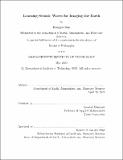Learning Seismic Waves for Imaging the Earth
Author(s)
Sun, Hongyu
DownloadThesis PDF (28.49Mb)
Advisor
Demanet, Laurent
Terms of use
Metadata
Show full item recordAbstract
This thesis studies imaging Earth’s interior with seismic wavefields for seismic exploration and monitoring, and shows applications of deep learning in solving challenges in seismic imaging with either active or passive seismic data. For active data, we develop deep-learning methods to extrapolate missing low-frequency waves from band-limited seismograms. Low-frequency waves are essential to mitigate the cycle-skipping problem of full-waveform inversion (FWI), but data below ∼ 3 Hz are missing due to the band-limited characteristic of conventional artificial sources. Here we train convolutional neural networks to computationally extrapolate low-frequency data from bandlimited recordings so that FWI can start from the extrapolated low-frequency data. We also extend the method to elastic FWI where the cycle-skipping phenomenon is more severe compared to acoustic FWI, due to the short S-wave wavelength. Additionally, involving real seismic data in training may reduce the generalization error for the network trained only on synthetic data. We thus develop a semi-supervised learning method and train generative adversarial networks with real data without real labels. Both synthetic and field examples show that the extrapolated low frequencies can successfully initiate FWI from rough initial models. Furthermore, we show that extrapolated low frequencies may be used to increase the investigation depth of surface-wave inversion for near-surface characterization. Moving from active to passive data, we develop deep-learning methods to extract accurate Green’s functions from realistic noise environments. Seismic interferometry by cross-correlation of ambient noise may introduce spurious events in correlograms if the source distribution is inhomogeneous. Extremely long (from days to months) noise recordings are usually required for a reliable retrieval with high signal-to-noise ratio. We therefore propose a deep-learning method to overcome the spatial limitation of passive sources for the universal application of seismic interferometry and the temporal limitation of noise recording length for real-time monitoring. Collectively, we find that deep neural networks can learn to generate seismic waves under the regression framework of machine learning. We conclude that machine learning is a powerful complement to traditional computational approaches and may provide new insights into the imaging of the Earth’s structure and dynamics.
Date issued
2022-05Department
Massachusetts Institute of Technology. Department of Earth, Atmospheric, and Planetary SciencesPublisher
Massachusetts Institute of Technology